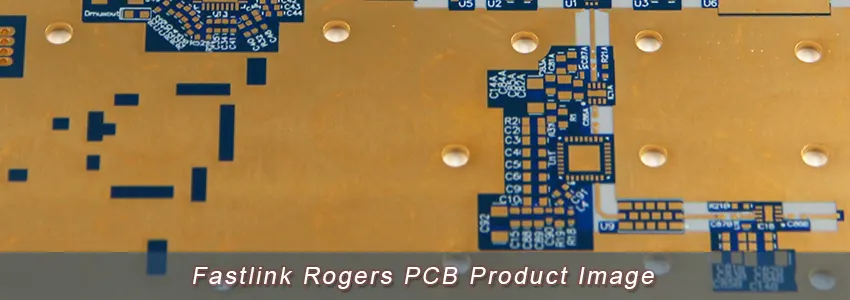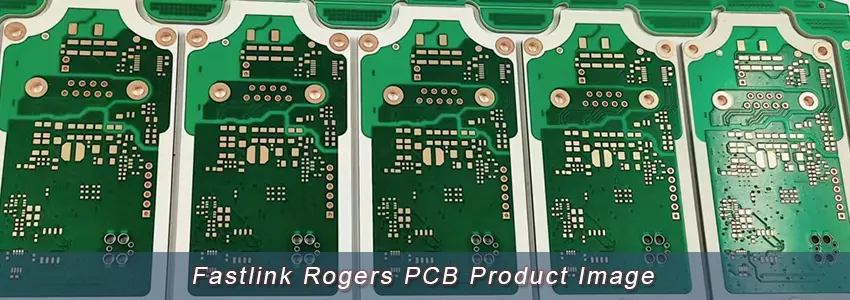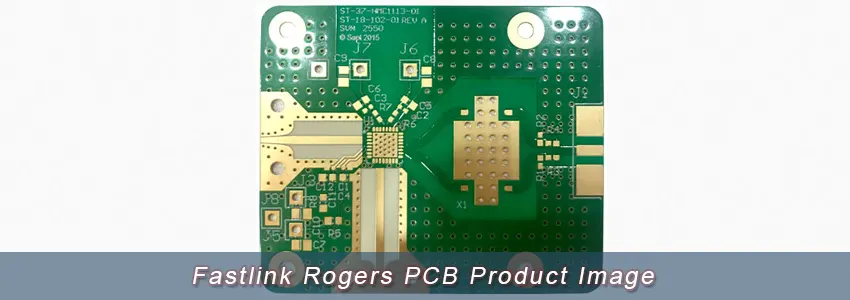- +86-0755-23597570-6067 Mon-Sun 0. 00-23. 59

Rogers PCBs allude to high-frequency circuit boards manufactured utilizing materials exclusively sourced from the Rogers Corporation. These laminates are generally employed in high-speed, commercial microwave, and radio frequency domains, providing an exceptional dielectric constant and temperature stability relative to standard FR4 materials. The low water absorption feature of Rogers laminates renders them suitable for high-humidity conditions.
Leveraging advanced PCB materials is instrumental in not only facilitating the construction of next-generation designs but also in reducing dielectric and electrical signal loss, among other benefits. Fastlink, as a Rogers PCB Manufacturer, maintains enduring collaboration with suppliers of Rogers materials, ensuring the provision of high-performance dielectrics, laminates, and prepregs from Rogers. Utilizing these specialized high-frequency circuit materials from Rogers, Fastlink manufactures Rogers PCBs that exhibit high-frequency and high-speed performance. The array of Rogers PCBs we offer is engineered to deliver enhanced thermal performance in extreme application settings.
FR-4 (or FR4) is a grade designation assigned to glass-reinforced epoxy laminate sheets, plates, and other composite materials. It is commonly used as a material for printed circuit boards (PCBs). FR-4 stands for “flame retardant,” and it complies with the UL94V-0 standard for flame resistance.
For electronic engineers and designers, FR-4 glass epoxy is a favored and flexible high-pressure thermoset plastic laminate grade with a decent strength-to-weight ratio. With nearly no water absorption, FR-4 is primarily used as an electrical insulator with significant mechanical strength. The material is recognized for maintaining its substantial mechanical values and electrical insulating qualities in dry and humid conditions. These characteristics and good fabrication traits contribute utility to this grade for a broad range of electrical and mechanical applications. Thus, FR-4 can operate effectively in most environmental conditions.
Rogers is a renowned manufacturer of laminate materials for creating Printed Circuit Boards (PCBs). While the typical PCB is comprised of an FR4 composite, a blend of glass fiber and epoxy resin, Rogers enhances this standard by offering FR4 laminates endowed with superior high-frequency characteristics. The core materials supplied by Rogers embody high-frequency properties akin to Teflon (PTFE).
Rogers proffers an extensive array of materials tailored for high-frequency PCBs, exhibiting relative permittivity from 2.3 to 10.2 and minimized dielectric losses:
● Rogers 4350B: This laminate material ensures meticulous control over the dielectric constant coupled with low loss performance. Despite employing standard FR4 processing, it is accessible at a comparatively lower price than typical microwave laminates and is UL 94 V-0 rated, marking its suitability for high-power RF designs.
● Rogers 3003: This material boasts exceptional stability of the dielectric constant across a vast spectrum of temperatures and frequencies. It is adept for ADAS, 5G wireless, and automotive radar applications operating at 77 GHz.
● Rogers RT/Duroid 6002: With its low dielectric constant and low loss, this material stands out for its superb electrical and mechanical properties, making it an ideal choice for microwave applications. It ensures reliability in multi-layered board designs.
● Rogers RT/Duroid 5880: Characterized by a low dielectric constant and minimal dielectric loss, this material is highly suitable for high-frequency/broadband applications. The randomly oriented microfibers reinforcing the PTFE composites contribute to maintaining a uniform dielectric constant.
● Rogers 4534: Offering an ideal balance between performance and cost, this material is apt for RF applications like antennas. The glass-reinforced, ceramic-filled composition ensures low loss performance, controlled dielectric constant, and a robust passive response to inter-modulation signals, marking its utility for microstrip antennas and mobile infrastructure. It is compatible with most lead-free, high-temperature solder reflow processing.
● Rogers 4003C: This laminate incorporates various styles of glass fabric such as 1080 and 1674, facilitating tight control on the dielectric constant and low loss. Despite utilizing standard epoxy/glass processing methods, it is cost-effective compared to traditional microwave laminates. It obviates the need for special through-hole treatments or handling procedures, typical for PTFE-based microwave materials.
1.The cost of FR-4 material is generally lower than that of Rogers material.
2.In comparison to FR-4 material, Rogers material exhibits superior performance at high frequencies.
3.FR-4 material possesses a higher dissipation factor or Df than Rogers material, leading to increased signal loss.
4.Regarding impedance stability, Rogers material offers a more extensive range of Dk values compared to FR-4 material.
5.Concerning the dielectric constant, FR-4 has a Dk of approximately 4.5, which is lower than that of Rogers material, which ranges from about 6.15 to 11.
6.In terms of temperature management, Rogers material demonstrates lesser variation compared to FR-4 material.

Choosing Rogers PCB material allows access to unparalleled high-frequency and microwave application performance. This choice is not just about meeting requirements but exceeding them, ensuring that the electronic components function optimally. Rogers materials are meticulously engineered to minimize signal loss at high frequencies, providing a robust platform for applications such as RF and microwave circuits. This heightened performance is crucial in delivering reliability and efficiency in advanced technological applications.
Rogers PCB materials stand out for their low dielectric losses, especially compared to traditional FR4 materials. This characteristic is not just a statistic but a guarantee of superior signal integrity and enhanced performance in high-frequency operations. Ensuring minimal signal loss means more reliable communication and operation for devices and systems built on Rogers PCBs, reinforcing the foundation for high-tech electronic applications.
Stability is not just preferred but essential in high-frequency applications, and Rogers materials deliver just that. They offer a stable dielectric constant over a wide frequency and temperature range, ensuring consistent and reliable performance. This stability transcends typical performance metrics, providing assurance in the material’s ability to withstand diverse operational conditions while maintaining its characteristics, making it a reliable choice for varied high-frequency applications.
Rogers materials are synonymous with superior thermal management. With lesser temperature variation, these materials ensure the longevity and reliability of PCBs, especially in high-power and high-frequency contexts. Effective thermal management goes beyond just performance; it’s about ensuring the durability and reliability of the electronic systems, making Rogers materials a strategic choice for applications requiring efficient temperature handling.
In the realm of high-frequency electronics, dimensional stability is paramount. Rogers PCB materials offer exceptional dimensional stability, essential for applications requiring exact tolerances. This feature is not just about meeting standards but about ensuring the precision and reliability of the PCBs in real-world applications, reinforcing the reliability and consistency of devices built on them.
Rogers materials may have different mechanical properties compared to standard FR4, necessitating special handling to prevent damage during the manufacturing process.
Designing for Rogers PCBs entails aligning the design specifications with the material’s properties. This alignment, involving considerations for thermal expansion, layer-stack planning, and impedance control, serves to enhance the performance of high-frequency applications.
The lamination process for Rogers materials may not mirror that of standard FR4. Paying special attention to lamination parameters such as temperature, pressure, and time is beneficial for achieving optimal bonding and material performance.
Given the distinct mechanical properties of Rogers materials, adherence to proper machining and drilling procedures is advisable. Using appropriate tools and techniques helps to avert material damage and maintain the precision and quality of the final PCB.
Effective thermal management holds significant importance in Rogers PCB manufacturing, especially considering their application in high-frequency and high-power contexts. It is prudent to factor in the thermal properties of Rogers materials to ensure the PCBs’ resilience against operational heat loads.
Ensuring the quality and performance of Rogers PCBs, particularly in sensitive and high-performance contexts, is a priority. Establishing comprehensive testing protocols, including electrical, thermal, and mechanical testing, aids in affirming the performance and reliability of the finished PCBs.
While Rogers materials stand out in performance, they do incur a higher cost compared to FR4. Practicing prudent cost management and budgeting in the manufacturing process assists in keeping the project within financial limits while still meeting performance goals.

Rogers PCBs have good electrical properties and thermal management capabilities, leading to their wide use in various advanced technological fields. Below are some of the key areas where Rogers PCBs are utilized:
Rogers PCBs are commonly used in aerospace and defense applications because of their high reliability and robustness in extreme environmental conditions. They are used in radar systems, antenna arrays, and communication equipment where high-frequency performance and thermal stability are paramount.
The telecommunication industry heavily relies on Rogers PCBs for various high-frequency applications, including base station antennas and microwave point to point (P2P) links. Their low dielectric loss makes them ideal for use in high-speed communication systems.
In the automotive industry, Rogers PCBs are employed in advanced driver-assistance systems (ADAS), radar systems, and vehicle-to-everything (V2X) communications. Their ability to operate efficiently at high frequencies ensures reliable performance in automotive applications.
Medical equipment such as diagnostic imaging devices, MRI systems, and other high-frequency medical electronics often use Rogers PCBs. The material’s stability and reliability contribute to the accuracy and effectiveness of medical devices.
Industrial electronics that require stable performance under varying conditions use Rogers PCBs. Applications include automation systems, sensor technologies, and other high-frequency industrial electronics.
At Fastlink, we offer a diverse range of Rogers PCB materials including Rogers 4003 PCB, Rogers 4350 PCB, Rogers 5880 PCB, RO3003 PCB, RO6002 PCB, Rogers FR4 PCB, TTM10 PCB, Rogers Ceramic PCB, and Rogers PTFE PCB, among others. Our robust engineering, procurement, production, and quality teams stand as a testament to our reputation as one of the most reliable Rogers PCB manufacturers in China. Please feel free to contact us for any Rogers PCB quotations.
We are duly certified with the following accreditations:
● IATF 16949:2016
● ISO 9001:2015
● ISO14001:2015
● ISO13485:2016
● UL
Furthermore, all our products adhere to the IPC & ROHS Standards. It is our continuous endeavor to produce premium quality PCB products.
